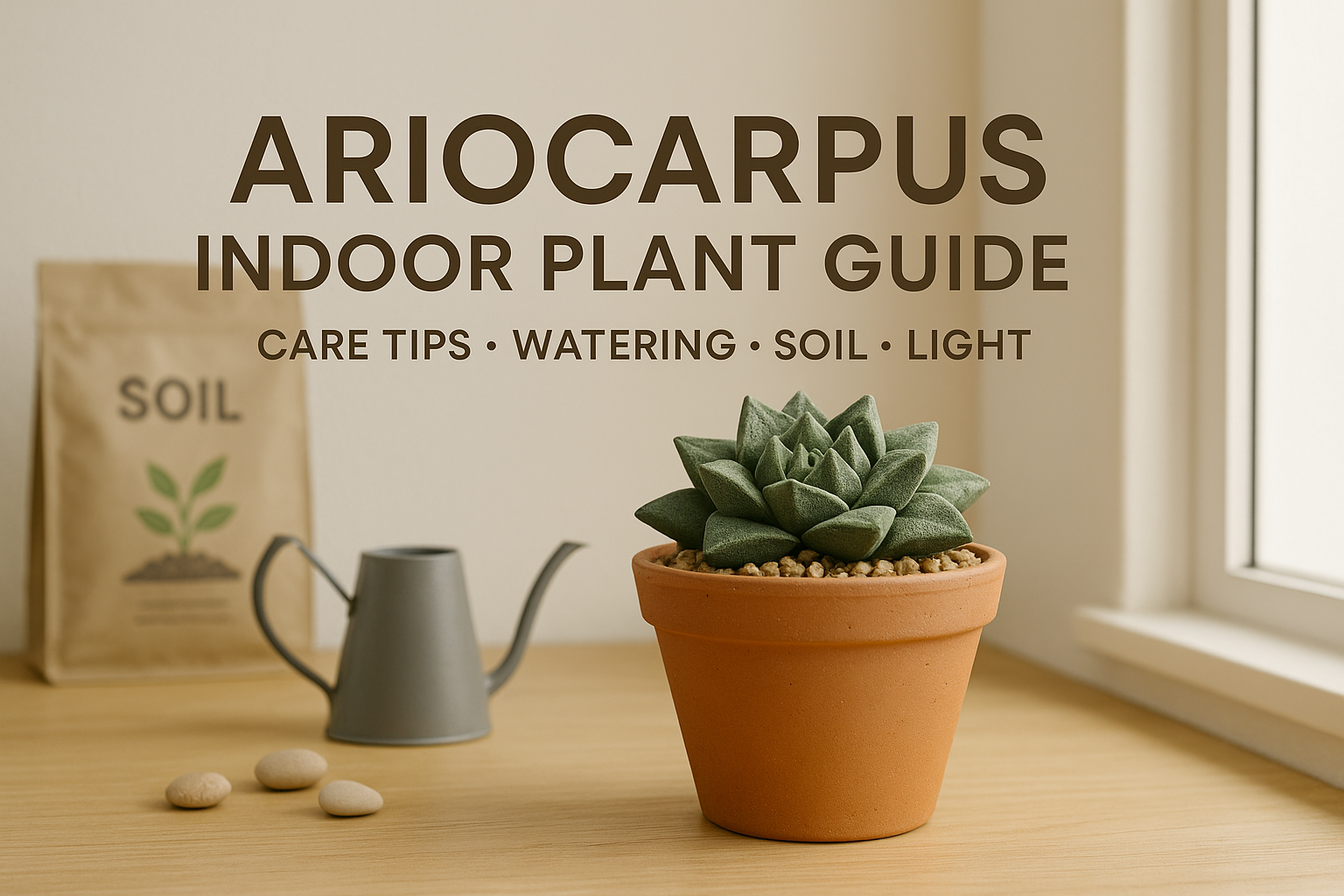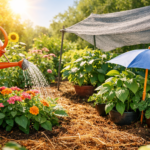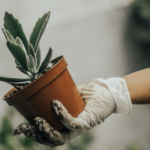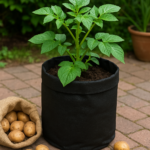Ariocarpus is a rare and fascinating genus of cacti known for its sculptural, rock-like appearance and slow-growing nature. Native to Mexico and parts of Texas, this unique plant is ideal for indoor environments where minimal care and compact size are preferred. Unlike typical cacti, Ariocarpus lacks prominent spines and produces stunning flowers in the fall, making it a prized specimen for collectors. Though it requires patience, its low water needs and striking form make it perfect for modern, minimalist homes.
In this guide, we’ll explore everything you need to know about growing and caring for Ariocarpus indoors.
What is an Ariocarpus Plant?

The Ariocarpus is a rare and slow-growing genus of cacti native to Mexico and parts of Texas. Unlike the typical cactus, it doesn’t have prominent spines but features a rosette of thick, triangular, tuberculate leaves that often resemble rocks or fossils—earning it the nickname “living rock cactus.” This camouflaged appearance helps protect it from herbivores in the wild. Ariocarpus species bloom with stunning flowers in pink, white, or yellow hues, typically during the fall, providing a dramatic contrast to their rugged exterior.
Indoors, Ariocarpus becomes a fascinating collector’s piece. It is not a beginner’s plant due to its extremely slow growth and specific care needs, but it’s highly rewarding for dedicated plant enthusiasts. One of its standout features is its caudex-like root system, which stores water and nutrients, allowing it to survive extended dry periods. While it may take several years to flower, its sculptural look and meditative growth process make it ideal for minimalist or desert-themed indoor spaces. If cared for properly, an Ariocarpus can live for decades and become a centerpiece of your indoor succulent or cactus collection.
Why Choose Ariocarpus as an Indoor Plant?
Choosing Ariocarpus as an indoor plant is ideal for plant lovers who appreciate low-maintenance yet visually unique specimens. Its rarity and sculptural shape make it a conversation piece, especially when it blooms. Unlike typical succulents that require frequent attention or outgrow their pots quickly, Ariocarpus thrives on minimal intervention. Its slow growth means you won’t have to repot often or deal with unruly foliage. The plant is incredibly drought-tolerant and only needs occasional watering—making it perfect for those with busy schedules or minimalist watering routines.
Another reason to choose Ariocarpus is its compact size. Many homes or apartments lack the space for large, spreading houseplants. Ariocarpus, on the other hand, remains relatively small even after many years, making it ideal for tabletops, desks, or windowsills. Its unique rock-like texture fits perfectly with contemporary, desert-themed, or even Zen-style interiors.
From an ecological standpoint, keeping Ariocarpus indoors can also help preserve wild populations. Since many wild Ariocarpus species are endangered due to over-collection, cultivating them responsibly in pots from nursery-propagated plants contributes to conservation. Whether you’re a seasoned succulent lover or an artful home decorator, the Ariocarpus brings a rare, sculptural, and rewarding presence to indoor living.
Ideal Indoor Conditions for Ariocarpus
Creating the perfect indoor environment for Ariocarpus means mimicking its native desert habitat while adapting to home conditions. First and foremost, light is critical. Ariocarpus needs bright, indirect sunlight—ideally from a south-facing window. While it can tolerate some direct sun, especially morning light, too much intense sunlight through glass can cause scorching. A grow light is a helpful supplement if your home doesn’t receive enough natural light, particularly during winter.
Temperature is another key factor. Ariocarpus prefers warm indoor temperatures ranging from 20°C to 30°C (68°F to 86°F) during its active growing season. It can handle cooler nighttime temperatures down to 10°C (50°F) in winter but must be protected from frost or sudden cold drafts. Humidity should be kept low—mimicking its dry desert origin. Avoid placing it in bathrooms or near humidifiers.
A well-ventilated spot helps prevent fungal issues, which Ariocarpus is particularly prone to if overwatered. Ensure the plant has good airflow around it, especially if you’re growing it in a terrarium or enclosed space. Lastly, keep the plant in a place where it won’t be disturbed, as its slow growth and sensitive root system mean it doesn’t recover quickly from stress.
Can I grow Ariocarpus from seed indoors?

Yes, you can grow Ariocarpus from seed indoors, but it requires patience and specific conditions. The seeds need warmth, bright indirect light, and consistently moist (not wet) soil to germinate. Germination can take several weeks, and growth is extremely slow—taking years to develop into a recognizable plant. Use a sterile, well-draining cactus mix and cover the seeds lightly. A humidity dome or clear cover can help maintain moisture during germination. It’s best to start seeds in spring when temperatures are more stable. While rewarding for experienced growers, most hobbyists prefer purchasing young, nursery-grown Ariocarpus due to the time investment.
Soil and Potting Needs
The success of Ariocarpus indoors hinges on the right soil and potting setup. This cactus is particularly vulnerable to root rot, so a fast-draining substrate is absolutely essential. Ideally, use a cactus-specific potting mix enhanced with gritty materials like pumice, perlite, coarse sand, and small gravel. Many collectors make their own blend—typically 50% organic matter (like cactus mix) and 50% inorganic materials for optimal drainage and airflow.
The pot itself should be shallow but wide, matching the plant’s natural growth habit. Terra cotta pots are recommended because they are breathable and allow moisture to evaporate faster than plastic or glazed ceramic containers. The pot must have drainage holes—this is non-negotiable. Never let the pot sit in standing water, as Ariocarpus roots are highly susceptible to rot.
Repotting should only be done every 3–5 years and only when absolutely necessary, such as when the plant becomes root-bound or the soil has degraded. When repotting, avoid disturbing the root system too much and allow the plant to rest dry for a week after repotting before watering. Adding a top dressing of gravel not only gives a neat finish but also helps reduce excess moisture around the crown.
Watering Schedule and Techniques
Watering Ariocarpus properly is the most critical part of its care, as overwatering is the leading cause of failure with this plant indoors. During its active growing season (spring to early fall), Ariocarpus should be watered sparingly—only when the soil is completely dry, which might mean watering every 3 to 4 weeks depending on humidity, pot size, and temperature. When watering, give the plant a thorough soak until water drains from the bottom, and then allow it to dry out completely before the next session.
In winter, Ariocarpus enters a dormant phase and should be kept almost completely dry. Reduce watering drastically—many growers skip watering entirely during these months, especially if the indoor temperature drops. If the plant begins to shrivel slightly, a very light watering may be given once every 6 to 8 weeks, but only if the soil is bone dry and the weather isn’t too cold.
Always water at the base and avoid getting water on the rosette to prevent rot. It’s also a good idea to use distilled or rainwater if your tap water is hard or high in minerals, as salt buildup can damage the roots over time. Monitoring your plant closely and adjusting your watering based on its cues is the key to long-term success.
Feeding and Fertilizing
Although Ariocarpus is a slow-growing plant, occasional feeding during its growth period can enhance health and flower production. Fertilize once a month during the spring and summer months using a low-nitrogen, high-phosphorus cactus fertilizer, ideally diluted to half strength. This promotes flowering and encourages healthy root development without overstimulating growth, which Ariocarpus cannot handle quickly.
Do not fertilize during the fall or winter when the plant is dormant. Excess nutrients during this time can disrupt its natural rest cycle and cause root stress or rot. Also, avoid using general-purpose fertilizers with high nitrogen content as these can damage the delicate tissues of this plant and cause overly soft growth, making it susceptible to pests and rot.
For organic options, you can use diluted compost tea or worm castings extract during the active season, although synthetic liquid cactus feed is generally easier to control. Always water the plant before applying fertilizer to prevent root burn. Consistent but minimal feeding keeps Ariocarpus healthy without forcing unnatural growth, which is key to its longevity indoors.
Common Problems and How to Prevent Them

Ariocarpus is susceptible to several indoor plant issues, primarily due to overwatering and poor ventilation. The most common problem is root rot, which happens when the soil stays moist too long. Signs include a mushy base, foul odor, or yellowing tubercles. Prevention includes proper soil, a pot with good drainage, and a strict watering schedule.
Pest infestations are rare but possible. The main culprits are mealybugs, which hide in the crevices and can stunt growth. Check the plant regularly and remove bugs with a cotton swab dipped in rubbing alcohol. Spider mites can also affect Ariocarpus in very dry homes; raising humidity slightly and wiping leaves with a damp cloth can help.
Fungal infections or soft rot may occur if water gets trapped in the rosette. Always water at the base and avoid overhead watering. Another issue is sunburn, which appears as pale or brown patches. Protect the plant from harsh midday sun or magnified window light. Finally, Ariocarpus can sometimes shrink or wrinkle—usually a sign of dehydration, which can be fixed with cautious watering.
Preventing problems is mostly about mimicking its native dry conditions: low humidity, fast-draining soil, minimal watering, and plenty of bright light.
Propagation and Flowering Indoors
Propagation of Ariocarpus is challenging, especially indoors. It typically grows from seed, but this process can take years before the plant reaches a recognizable size. Seeds need warmth (about 25°C/77°F), consistent moisture (without soaking), and bright, indirect light to germinate. Most indoor gardeners opt to buy mature nursery-grown plants rather than start from seed due to the time investment.
Grafting is another method sometimes used by collectors to speed up growth, but this is more common in greenhouses and less suitable for casual indoor gardeners.
When it comes to flowering, patience is key. Ariocarpus can take 4 to 10 years to flower, even in ideal conditions. The flowers appear in autumn and last a few days, with vibrant pink, white, or yellow petals. Ensure the plant receives plenty of sun and proper feeding during the spring and summer to encourage blooming. A slight stress period—cooler temperatures and dry soil in the winter—can trigger flowering the following season.
While flowering indoors is a rare event, it’s a rewarding milestone for any Ariocarpus grower. The flower emerges from the center of the rosette and creates a stunning contrast against its rough, stone-like foliage—like a jewel emerging from stone.
Final Thoughts:
In conclusion, the Ariocarpus plant is a rare and rewarding indoor cactus ideal for collectors and enthusiasts who appreciate slow-growing, sculptural plants. Its unique rock-like appearance, low water needs, and compact size make it perfect for minimal, low-maintenance indoor spaces. Though it requires patience and specific care, its resilience and occasional stunning blooms make it a true gem in any succulent collection. With proper lighting, well-draining soil, and minimal watering, Ariocarpus can thrive indoors for decades. If you’re seeking a distinctive plant that offers both beauty and longevity, Ariocarpus is an exceptional choice for your indoor garden.
Frequently Asked Questions (FAQ)
1. Is Ariocarpus suitable for beginners?
Ariocarpus is best suited for intermediate to advanced plant lovers. While it’s low-maintenance in terms of watering, it requires precise care with soil, light, and temperature. Beginners may find its slow growth and sensitivity to overwatering challenging.
2. How often should I water my Ariocarpus?
Water only when the soil is completely dry. This could be every 3–4 weeks in the growing season and once every 6–8 weeks—or not at all—in winter. Overwatering is the most common mistake with this plant.
3. Does Ariocarpus need direct sunlight?
It thrives in bright, indirect sunlight. A few hours of gentle morning sun are ideal. Harsh midday sun through glass can cause sunburn. A south or east-facing window is recommended.
4. How long does it take for Ariocarpus to flower indoors?
It may take 4 to 10 years to flower, depending on conditions and the plant’s age. Blooms typically appear in the fall and can last several days.
5. What type of soil should I use?
Use a gritty, fast-draining cactus mix. Add pumice, coarse sand, or perlite to improve drainage and reduce the risk of root rot.
6. Why is my Ariocarpus wrinkling or shrinking?
This usually indicates dehydration. If the plant is in its growing season, water thoroughly and wait for it to rehydrate. If it’s winter, avoid watering unless absolutely necessary.







